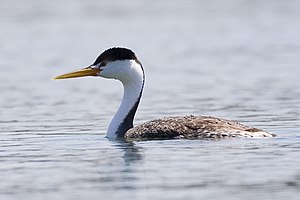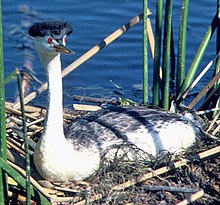Clark diver
| Clark diver | ||||||||||
|---|---|---|---|---|---|---|---|---|---|---|

Clark's diver ( Aechmophorus clarkii ) |
||||||||||
| Systematics | ||||||||||
|
||||||||||
| Scientific name | ||||||||||
| Aechmophorus clarkii | ||||||||||
| ( Lawrence , 1858) |
The Clark diver ( Aechmophorus clarkii ) is a grebe that lives in North America . Until the 1980s it was often thought to be a paler morph of the racing diver .
features
With a body length of 51–74 cm, the Clark diver is significantly larger than a great crested diver . The weight is between 550 and 1225 g. With its long beak, long neck and white-black to dark-gray-brown color, it is very similar to the closely related racing diver. As with this one, there is no distinctive hood. The two species can be distinguished by the lighter, orange-yellow beak color of the Claret divers. In addition, the area in front of the eye is white in the Clarktaucher - a feature that can be less pronounced in a simple dress. The flanks are lighter than those of the racing diver, but this is not a particularly reliable species feature. The sexes are similar; the female is somewhat smaller and more short-billed.

In adult birds in breeding plumage, the iris is orange-red and surrounded by a yellow to orange, bare orbital ring, from which a narrow web extends to the cleft of the beak. The beak is orange-yellow with a slightly darker ridge. The slate-black color of the forehead, crown and nape of the head lightens somewhat towards the back; the rest of the top is dark slate gray. The area of the face, including the reins and sometimes the stripes above the eyes, is white, as is the chin, throat, front neck and the underside. Only the flanks are dark slate gray and interspersed with white to a variable extent. The upper wing is predominantly dark gray with almost white arm and inner hand wings, with the hand wings showing a dark tip border that steadily widens towards the dark gray wing tip. The lower wing is lighter than the upper wing. It shows a similar pattern, but it is less clear. The arm covers are whitish, the axillary feathers gray. The legs and feet are dark slate gray on the outside, olive to yellowish on the inside.
The plain dress is similar to the brood dress. Often the area above and behind the eye is colored gray. Birds in their youthful dress are similar to adult animals, but appear a bit gray overall.
Distribution and geographic variation
The Clark diver inhabits large parts of western North America from southern Canada south to California , Arizona and Colorado , where it is only found scattered. Another population exists in the area of the Mexican plateau. Two subspecies are recognized, of which A. c. transitionalis is slightly larger than the nominate form .
- A. c. clarkii ( Lawrence , 1858) - from northern Chihuahua south to Nayarit , northern Guerrero , San Luis Potosí and Puebla ; possibly also on Caballo Lake in New Mexico .
- A. c. transitionalis Dickerman , 1986 - from southern British Columbia south to California, western Arizona and southern Colorado.
hikes
Most Canadian and US breeding birds presumably winter together with racing divers on the coast of the Pacific and, less often, on the Gulf of Mexico . Claret divers breeding further south are presumably resident birds , which at best make locally limited changes of location.
habitat
The clear diver breeds in inland waters and brackish swamps, lakes, retention basins and ponds. Larger, open water areas are preferred, the banks of which are usually overgrown with rushes or sour grasses. In places where the species occurs together with the racing diver, it seems to use the middle of the water and deeper areas.
nutrition
Little is known about the diet of the Clark diver. It probably resembles that of the racing diver and consists mainly of fish and, especially during the breeding season, also of aquatic insects. Much smaller fish than racing divers were found in the stomachs of female Clark divers; however, this observation was not confirmed in males. In contrast to the racing diver, the species seems to hunt further away from the shore and at greater depths. During the breeding season, the birds can be observed individually or in pairs. Outside the breeding season, they are quite sociable and socialize with the racing diver.
Reproduction
The breeding season in the north is between May and July; in Mexico it extends partly into October. There is an annual brood. The species breeds in common colonies with the racing diver, which often consist of hundreds or thousands of nests. Occasionally, however, individual breeding pairs can also be found.
The nest is a stable platform made of plant material that is floating or erected on the ground. The clutch consists of 3–4 eggs. A number of up to seven are probably clutches of two females in one nest, which is not uncommon in colonies of this genus. The eggs are incubated for about 23 days, the young are cared for by their parents for between 63 and 77 days.
The breeding success can vary greatly. In mixed colonies with the racing diver, the species has higher breeding successes. For example, in a colony with 18.6% of Clark divers, the proportion of couples with breeding success was 33.6%.
Duration
The Clark diver is not threatened. In the north it is much rarer than the racing diver, towards the south the frequency increases steadily and in California the Clark diver is the more common species. Nothing is known about the population in Mexico. It's probably not very big. Presumably, the species is affected by the same causes of danger as the racing diver: Habitat changes up to destruction such as the drainage of wetlands, human disturbance to breeding colonies, water pollution and tangling in fishing nets. In central Mexico, mowing cornices for industrial weaving seems to have a negative impact on breeding success in many places . In northern Mexico, the Clark divers breed almost exclusively on artificial water reservoirs. Presumably, the increased installation of the same in the 20th century strongly promoted the spread of the species there.
Etymology and history of research
George Newbold Lawrence described the Clark diver under the name Podiceps clarkii . He had three type specimens available for analysis. John Henry Clarke (1853–1931) collected one of them in Chihuahua .
The term “Aechmophorus” is derived from the Greek words “aikhmē ακόντιο ” for “spear” and “pherō πιάζω ” for “to carry”. The specific epithet »clarkii« is dedicated to its collector. The word "transitionalis" is of Latin origin and means "to pass over".
literature
- Francesc Llimona, Josep del Hoyo , Arnau Bonan: Clark's Grebe (Aechmophorus clarkii). In: Josep del Hoyo, Andrew Elliott, David Christie: Handbook of the Birds of the World . Volume 1: Ostrich to Ducks. Lynx Edicions 1992 (revision 2013), p. 196.
- Robert William Dickerman: Two hitherto unnamed populations of Aechmophorus (Aves: Podicipitidae) . In: Proceedings of the Biological Society of Washington . tape 99 , 1986, pp. 435-436 ( online [accessed October 10, 2013]).
- George Newbold Lawrence: Podiceps Clarkii Clark's tanning . In: Reports of explorations and surveys, to ascertain the most practicable and economical route for a railroad from the Mississippi River to the Pacific Ocean. Made under the direction of the secretary of war, in 1853–6 . tape 9 , 1858, pp. 895 ( online [accessed October 10, 2013]).
Web links
- Aechmophorus clarkii inthe IUCN Red List of Threatened Species 2013.1. Listed by: BirdLife International, 2012. Retrieved October 10, 2013.
- BirdLife International: Species Factsheet - Clark's Grebe ( Aechmophorus clarkii ) . Retrieved October 10, 2013.
- Videos, photos and sound recordings of Clark's Grebe (Aechmophorus clarkii) in the Internet Bird Collection
- xeno-canto: Sound recordings - Clark's Grebe ( Aechmophorus clarkii )



